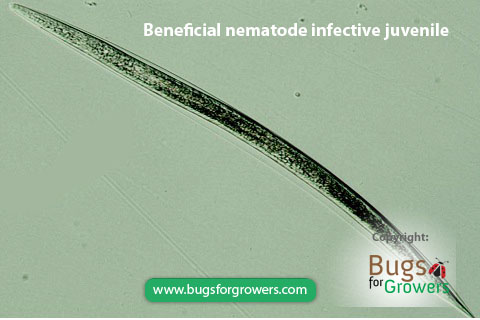Biological control of mushroom flies
Biological control of mushroom flies with beneficial entomopathogenic nematodes like Steinernema feltiae and Steinernema carpocapsae can be very effective as compared to other biological control agents. Beneficial entomopathogenic nematodes (Photo 1) are safe to apply because they are not harmful to humans and the environment and easy to apply in the mushroom houses. Both Steinernema feltiae and S. carpocapsae nematodes have been proved to be effective in controlling both phorid and sciarid mushroom flies, the key pests of mushroom crops (Agaricus bisporus) grown in mushroom houses (Jess et al., 2005; Scheepmaker et al., 1998). The larvae (also called maggots) of both the mushroom flies cause direct or indirect damage to mushrooms and their adults are nuisance to workers. Adults of phorid flies are known vectors of both bacterial and fungal pathogens especially Verticillium spp. The maggots of phorid flies, Megaselia halterata can feed externally on mushroom mycelium wheres maggots of Sciarid flies, Lycoriella auripila can bore into mushroom stems and feed internally. Recently, it has been demonstrated that the application of both Steinernema feltiae and S. carpocapsae nematodes against phorid flies, Megaselia halterata and Sciarid flies, Lycoriella auripila caused a significant mortality of Lycoriella auripila but not the mortality of Megaselia halterata. Also, Steinernema feltiae was comparatively more effective than S. carpocapsae in killing Lycoriella auripila (Navarro and Gea, 2014).

What are phorid flies?
There are two known species of Phorid flies including Megaselia halterata and Megaselia nigra cause a serious damage to mushrooms. The larvae of both of these phorid flies generally feed on mushroom mycelium and their adults are known to transmit the disease causing organisms especially Verticillium spp.
What are sciarid flies?
There are five species of Sciarid flies from two different genus namely Lycoriella and Bradysia cause a serious damage to mushroom. The larvae of all of the five species including Lycoriella ingénue, Lycoriella castanescens, Bradysia brunnipes, Bradysia difformis and Bradysia lutaria feed on mycelium. These larvae can also feed internally by tunneling into mushroom stems.
What are beneficial Steinernema feltiae nematodes?
Beneficial Steinernema feltiae nematode are cold tolerant nematodes that can infect and kill insects as low as 10°C temperature. This nematode uses an intermediate foraging strategy that is between the ambush (Sit- and -wait for host to come by) and cruiser (actively search and infect hosts) type. This nematode is most effective against mushroom flies and fungus gnats in mushroom houses and greenhouses, respectively. Steinernema feltiae nematode infective juveniles (Photo 1) carry species specific symbiotic bacteria Xenorhabdus bovienii in their gut as weapon to kill their insect hosts. As other species of entomopathogenic nematodes, Steinernema feltiae nematodes also enter their insect host’s body cavity through the natural openings such as mouth, anus and spiracles. Once in the cavity, infective juveniles releases symbiotic bacteria Xenorhabdus bovienii, which multiplies rapidly in the insect blood, causes septicemia and kill its host within 48 hours of infection. The optimum temperature range for this nematode’s activity and infection is a very wide ranging from 50 °F (10 °C) to 77 °C (25 °C).
What are beneficial Steinernema carpocapsae nematodes?
Beneficial Steinernema carpocapsae nematodes are active at many temperatures but they are most effective against many insect pests at temperatures ranging from 22 to 28°C. This nematode is an “ambush forager”, which means it uses a sit-and-wait strategy meaning it stands on its tail in an upright position and attacks highly mobile insects such as billbugs, sod webworms, cutworms and armyworms. Infective juveniles of Steinernema carpocapsae always carry symbiotic bacteria, Xenorhabdus nematophila in their gut and use them as a weapon to kill their insect host. When the infective juveniles of Steinernema carpocapsae are applied to the soil surface in the fields or thatch layer on golf courses, they start searching for their insect hosts. This nematode also can find and kill its host beneath soil surface. Once insect larva has been located, the nematode infective juveniles penetrate into the larval body cavity via natural openings such as mouth, anus and spiracles. In the body cavity, infective juveniles release symbiotic bacteria, Xenorhabdus nematophila from their gut in insect blood where multiplying nematode-bacterium complex causes septicemia and kill their insect host usually within 24-48 hours after infection.
Recommended rates of both Steinernema feltiae and Steinernema carpocapsae nematodes
Area in sq. ft. = Number of nematodes required
1………………………………………..23,000
100………………………………..2,300,000
500…………………………….. 11,500,000
1,000………………………….. 23,000,000
43,560 (1 Acre)………….1,000,000,000
For more information on the dosages of nematodes and percent mortality of mushroom flies, read following papers.
- Jess, S. Schweizer, H. and Kilpatrick, M. 2005. Mushroom Applications. In Nematodes as biological control agents (ed. Grewal, P.S., Ehlers, R.-U. and Shapiro-Ilan, D.I. CABI Publishing, pp 191-213.
- Navarro, M.J. and Gea, F.J. 2014. Entomopathogenic nematodes for the control of phorid and sciarid flies in mushroom crops. Pesquisa Agropecuária Brasileira 49: 11-17.
- Scheepmaker, J.W.A. Geels, F.P., van Griensven L.J.L.D., and Smits, P.H. 1998. Susceptibility of larvae of the mushroom fly Megaselia halterata to the entomopathogenic nematode Steinernema feltiae in bioassays. BioControl 43: 201–214.
